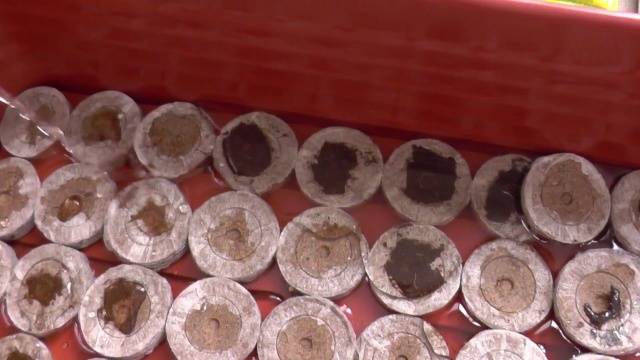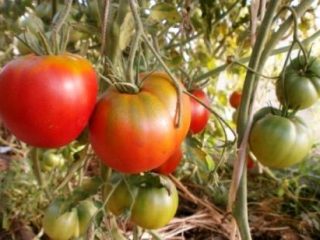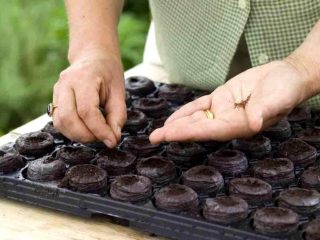Content
Tomato seedlings transplanted with the root system preserved take root more easily; tomatoes begin to bear fruit 1 - 2 weeks earlier than those whose roots were injured during replanting.
Seed preparation
Before sowing, it is necessary to prepare the seeds. If pelleted tomato seeds are planted, no preparation is required; they have already been treated with special substances by the manufacturer.
Pre-sowing preparation includes the following stages:
- Treatment against pathogens of infectious diseases;
- Treatment with growth stimulants;
- Soaking in complex fertilizer.
Preventive treatment against fungal and bacterial diseases is carried out by soaking in disinfectants, for example, in a solution of potassium permanganate. Tomato seeds are placed in a small fabric bag; if you plan to sow several varieties, it is advisable to label the bags. The seeds are placed in a solution with a disinfectant for 2 - 3 hours, after which they are thoroughly washed under running water.
Before planting old tomato seeds, it is advisable to treat them with growth stimulants. They contain phytohormones that will help tomato seeds germinate faster and stimulate further development.
Complex fertilizers contain potassium and manganese, the deficiency of which interferes with normal plant growth. If the tomato bush from which the seeds were collected lacked these nutrients, their content in the seeds will be insufficient for normal development. Such seeds have low germination; often young tomato sprouts stop developing at the cotyledon leaf stage. You can compensate for the lack of nutrients by soaking tomato seeds in a solution of complex fertilizers. Soaking is usually carried out during the day.
Peat pots
They are lowland peat, compressed in the form of pots. May be infused with additional nutrients and stimulants.
The main advantages of pots for growing tomato seedlings:
- Allows you to transplant seedlings without damaging the roots;
- Takes up little space when stored;
- Improve the structure and chemical composition of the soil;
- The pots are very convenient to use.
The convenience of peat pots is that tomato seedlings do not need to be taken out of them - they can be planted in a permanent place along with the pot, since the roots of the tomatoes grow freely through the walls. In addition, peat improves the structure of the soil, makes it lighter, and enriches it with nutrients.
Does not require special preparation before planting seeds. It is enough to fill the pot with a nutritious earthen mixture, place it in a tray and water it. A small depression is made in the soil, into which two or three tomato seeds are placed; after sprouting, one of the most developed sprouts is left, and the rest are pinched.It is not advisable to pull out excess tomato sprouts; you can damage the root system of the remaining ones.
As tomato seedlings grow, it is necessary to regularly inspect the pots to prevent roots from growing into the adjacent one.
Peat tablets
Peat tablets are compressed pieces of lowland or midland peat placed in a special, easily decomposed material. May contain an additional complex of nutrients. Designed for germinating seeds and growing seedlings after picking.
You can plant tomato seedlings together with a peat tablet; the mesh quickly dissolves in the soil and does not interfere with the growth of the root system. Peat will improve the composition of the soil and enrich it with substances necessary for plants.
The main advantages of peat tablets for growing tomato seedlings:
- Seedlings are planted without damaging the root system;
- The composition contains all the necessary nutrients;
- Does not contain fungal spores and weed;
- Easy to transport and store;
- Tomato roots develop quickly due to their light structure;
- They don't take up much space.
Before using peat tablets for growing tomato seedlings, you need to place the tablets in a tray and soak them in warm, but not hot water for 1 - 2 hours, drain off excess water after soaking. During this time, the volume of the tablet increases in size up to 5 times.
The upper part of the peat tablet is not covered with a mesh and has a small depression where 1 - 3 tomato seeds are placed, covered with soil on top and covered with transparent material until the tomatoes sprout. Tomato seeds usually germinate within one week; old or poor quality seeds may take longer to germinate.
If peat tablets are used for picking tomato seedlings, the recess is made larger; the roots and about a third of the stem should fit in it. The tomato sprout is carefully transferred to the resulting recess and carefully covered. You can water the plant a little, directing the stream at the stem of the tomato to lightly compact the soil.
Tomato seedlings should be watered carefully, avoiding waterlogging; the upper surface of the tablets must dry out between waterings. Overwatering has a detrimental effect on the root system and interferes with the normal absorption of nutrients.
It does not pose a particular danger to tomato seedlings, but it is advisable to get rid of it before its spores grow deep into the tablet. Usually, a single treatment with soda solution is sufficient for this.
Coconut tablets
They consist of pressed coconut fibers placed in a fine mesh. They can be additionally impregnated with nutrients necessary for growing tomato seedlings. Used for germination of seeds, picking seedlings, cuttings.
Coconut tablets have a number of advantages for growing tomato seedlings:
- Seedlings are protected from fungal diseases;
- Plants receive all the elements necessary for growth;
- Does not contain harmful insect larvae;
- Does not contain weed seeds;
- Do not lose shape during use.
- They make it possible to preserve the root system.
Before using coconut tablets for growing tomato seedlings, it is advisable to rinse them under running water for several minutes; sea salt is often used during the production process, which must be washed off. After this, the coconut tablets are placed in a tray or other container and filled with water at room temperature. After the tablets swell, excess water must be drained.
Tomato seeds are placed in the depression located at the top of the coconut tablet. As a rule, several seeds are placed in one tablet; after the sprouts appear, the most developed one is left, and the rest are pinched.
If coconut tablets are used for picking tomato seedlings, the recess is widened so that the root system of the seedling and a third of the tomato stem should fit in it; the sprout can be planted slightly obliquely. Gently sprinkle with soil and water the seedlings if necessary.
Plastic cups
Many gardeners traditionally use plastic cups for growing seedlings.
Main advantages for growing seedlings:
- Easy to purchase, sold in any store;
- Convenient to use for growing seedlings and transport;
- Can be used for growing seedlings several times;
- It is easy to sign; the necessary information can be written with a marker.
There is only one drawback of plastic cups - it is inconvenient to get the seedlings out; often, when taken out, the earthen ball crumbles and the young roots are injured.
Before planting seedlings in plastic cups, be sure to make drainage holes.Drainage holes are made at the bottom of the cup; each diameter should be about 1 cm.
The cups are filled with soil, tamping down a little. Do not fill the cup with soil to the top - this will complicate watering the seedlings; you must leave a distance of about 2 cm to the edge.
The planted seeds are covered with soil and watered a little; you can use a spray bottle for watering. After planting, the seeds are covered with transparent material to prevent the top layer of soil from drying out.
This will help when replanting to more easily determine the distance at which the tomato bushes should grow.
If it is needed plant seedlings After picking, it is advisable to cover the sprout with soil, which is kept suspended. To do this, place a little soil mixture at the bottom of the cup, hold the sprout vertically, lowering it into the cup. The soil is carefully filled, trying not to damage the roots of the seedlings; after planting, the tomatoes are watered.
Packages for seedlings
The most economical way to grow seedlings. You can use both purchased special bags intended for growing seedlings and those made by yourself.
Advantages of ready-made bags for tomato seedlings:
- Dark material does not allow sunlight to reach the roots of the seedlings;
- Have drainage holes;
- The seams of such bags are more durable;
- They have a flat bottom;
- They are inexpensive;
- Easily installed in drawers, saving space.
Before planting, the bags are filled with a nutritious earth mixture, which must be compacted slightly and placed in pallets or boxes. Tomato seeds are placed in a small hole, watered and the entire box is covered with plastic wrap until germination.
It is also advisable to cover the picked tomatoes with film for 5 - 8 days to make it easier for the tomatoes to recover. It is necessary to turn the film over once a day so that condensation does not damage the plants.
Conclusion
When choosing a method for growing tomato seedlings, you must take into account all possible conditions and circumstances in order to avoid disappointment.
















